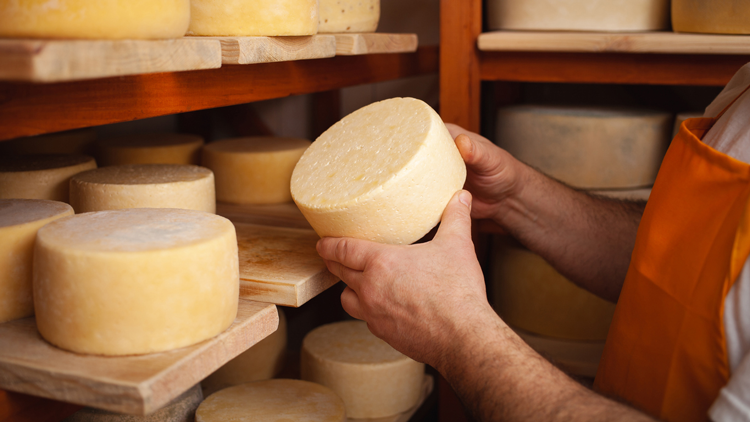The author is vice president of economics and legislative affairs at Agri-Mark, Inc.
January milk production fell 1.1% compared to last year, continuing the now seven-month trend of negative year-over-year growth. The national dairy herd continues to contract (down 0.8% year over year), while milk per cow has been, on average, flat. Reflective of the shrinking herd, slaughter rates were negative for the fifth consecutive month, down 16% in both December and January.
January’s cold storage report showed total cheese inventories grew for the sixth consecutive month by a modest 0.5%. The growth can be attributed to a 1.6% increase in Cheddar cheese inventories (the product that we price milk on), offset by a 0.9% reduction in Italian cheese inventories. Meanwhile, butter inventories started their seasonal build but in January were down 5.8% year over year, after a notable and surprising counter seasonal 7.8% decline in December.
The spread between classes
These data points shed light on a relatively tight milk supply, but more importantly, they reveal the ongoing difference between Class III and IV markets. While these dynamics are not new, this data and the latest market movements indicate a greater likelihood that the relationship is here to stay.
Milk continues to make its way into cheese vats. Cheddar cheese inventories remain healthy. Announced cheese capacity expansions will exacerbate the pull of milk into Class III plants at the expense of Class IV plants.
Short-term cheese export bookings will remain a factor in the yo-yo of cheese prices we’ve seen for the last 12 months. Meanwhile, Class IV inventories are trending lower than last year. Butter production is starting to see a comeback, but nonfat production has seen double-digit year-over-year declines for seven months now. In summary, short supply is benefiting the Class IV side of the equation more than Class III.
Barring an unexpected disruption in supply or demand, market fundamentals are not expected to change in the near term. On the supply side, new capacity will eventually drive milk production growth; however, milk supply is expected to grow only marginally in the short term. With heifers in a deficit, dairy farmers will need to focus on yields and keeping animals milking for an extra lactation. Paired with Class III capacity, that milk will find its way into cheese and whey, leaving Class IV capacity short.
Change is needed
The Class III and IV divergence is creating winners and losers. Farmers in Class III markets will be challenged with the 2024 average Class III price projection at $17.40. Conversely, farmers in Class IV dominant markets will have the advantage of a $20.35 average projected price for 2024.
This divergence also creates massive Class I skim revenue losses for producers. Any time the Class III and Class IV spread is over $1.60, the old “higher of” mover would have benefited farmers far more than today’s current “average of” mover.
Today’s marketplace is not expected to change in the near-term. This year’s average spread is projected to be nearly $3, highlighting the importance of a solution to the Class I mover.
Outside the marketplace
There are also winners and losers operating within the Federal Milk Marketing Orders (FMMO). One of the pillars of federal orders is revenue pooling. Revenue is shared, or pooled, within an order to create an even playing field among farmers within a milkshed. This only works if the order is reflective of the realities of the current marketplace. There is wide consensus in the industry that in many ways, the current order language (last changed in 2008) is not.
One such example is make allowances. Make allowances represent the cost of processing required to transform raw milk into a commodity product. Make allowances are static until a USDA hearing rules otherwise. In the 16 years since the last USDA hearing decision, though, efficiencies have been gained and costs of processing have gone up in areas such as labor and insurance, to name a few.
Those costs are not captured in today’s federal order minimum pricing. Instead, those involved in the manufacturing of Class III and IV products must capture costs outside of federal order pricing, placing those farmers who have invested in Class III and IV assets at a competitive disadvantage compared to those who have not.
At the end of January, USDA concluded a five-month hearing to modernize the FMMO system. USDA is expected to issue a preliminary decision in early summer and a final decision by early fall. The proposal will go to producer referendum around the end of the year, and if producers vote positively, changes are expected to be implemented the first half of 2025. Until then, outdated make allowances will cause pain to some but not others.
In the long term, the industry is aligned in pursuing efforts to keep FMMOs and make allowances relevant to avoid today’s competitive disadvantage from occurring into the future. This effort will require legislative action, which is fraught with its own delays and challenges.
The combination of divergent Class III and IV pricing and outdated make allowances is creating massive variability on producer milk checks. Both fundamental market shifts and FMMO changes will be required to even the playing field.



